Hoya Burtoniae and Hoya Bilobata are two popular and unique varieties of Hoya plants commonly grown in homes and gardens.
Although they may look similar at first glance, a few distinct differences between the two are important to understand. That’s why I think the topic of Hoya Burtoniae vs Bilobata is worth discussing.
Distinguishing these differences can help you choose the right plant for your needs and also ensure that you provide them with proper care.
This article will provide a comprehensive overview of Hoya Burtoniae and Hoya Bilobata. We’ll include their physical characteristics, habitat, growing and care requirements, and other important features.
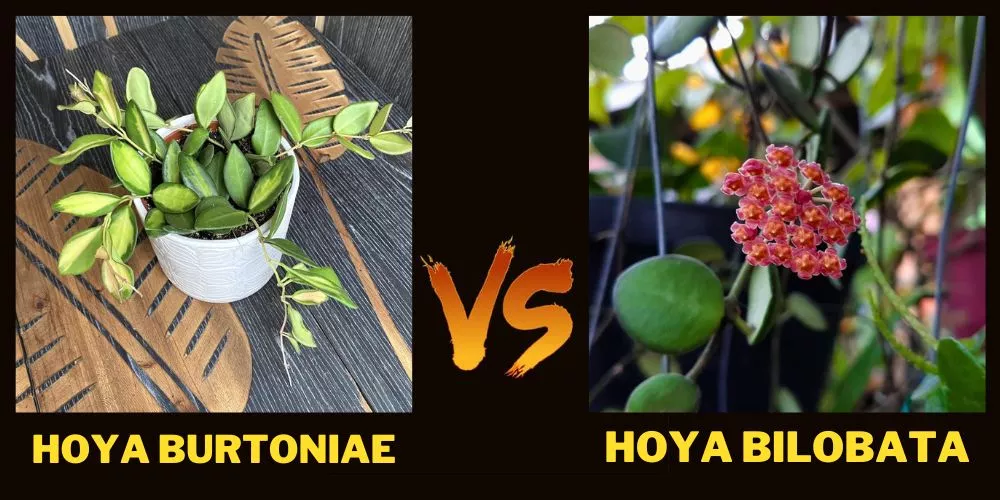
By the end of this article, you’ll better understand the differences and similarities between these two plants. You’ll also be armed with valuable tips on caring for and propagating them.
Whether you are a beginner or an experienced plant parent, this article will provide useful insights into the world of Hoya plants.
Table of Contents
Hoya Burtoniae: A Brief Overview
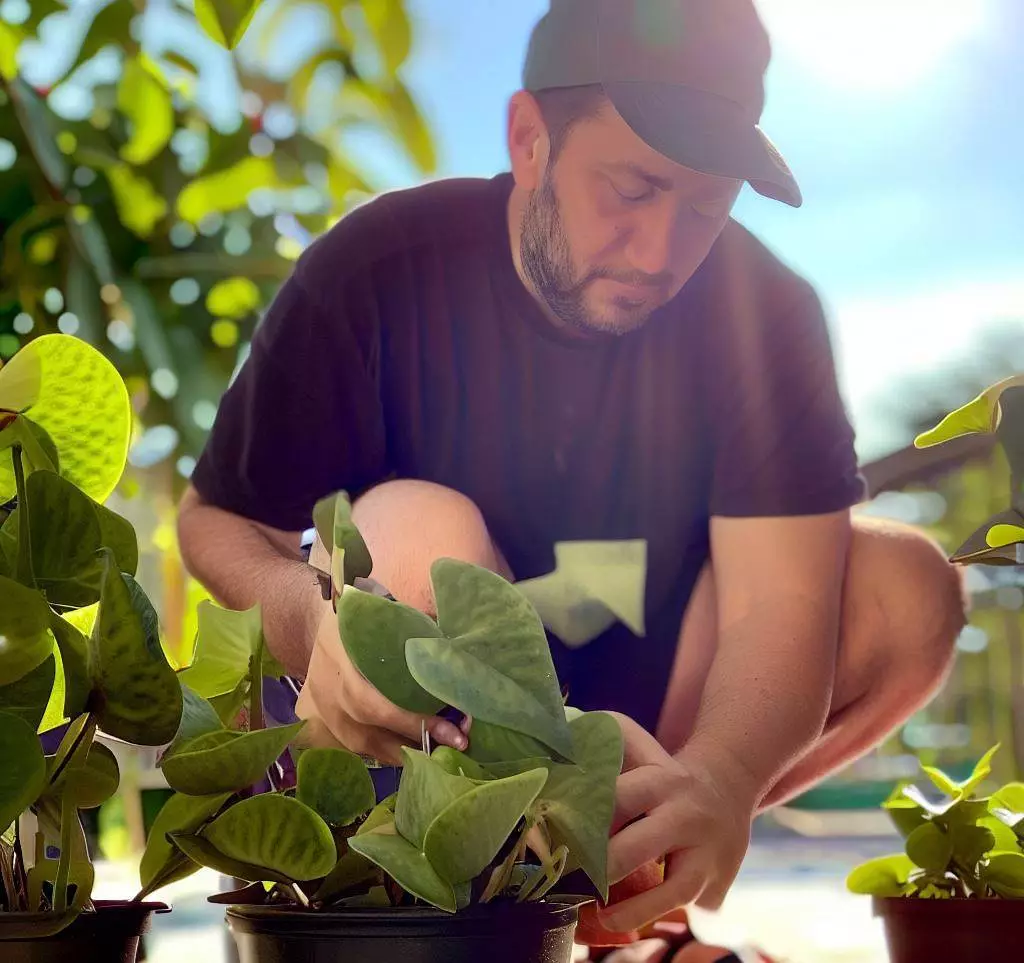
Type of the Plant
Hoya Burtoniae, also known as Wax Plant, is a unique and popular Hoya species native to the Philippines. This plant is a vining succulent that produces beautiful, star-shaped, waxy flowers with a beautiful sweet fragrance. The flowers pop out in clusters of up to 20, typically either pink or white with a pink center.
Habitat and distribution
Hoya Burtoniae is native to the rainforests of the Philippines, where it grows as an epiphyte on tree trunks and branches. It can also be found in the islands of Mindanao and Luzon, both located in the southern part of the Philippines.
However, It is specifically known to grow in Davao, Zamboanga, and Quezon provinces.
Hoya Burtoniae often grows on tall trees in the wild and climbs toward the light. Its leaves are thick and fleshy, which helps it retain moisture and tolerate periods of drought.
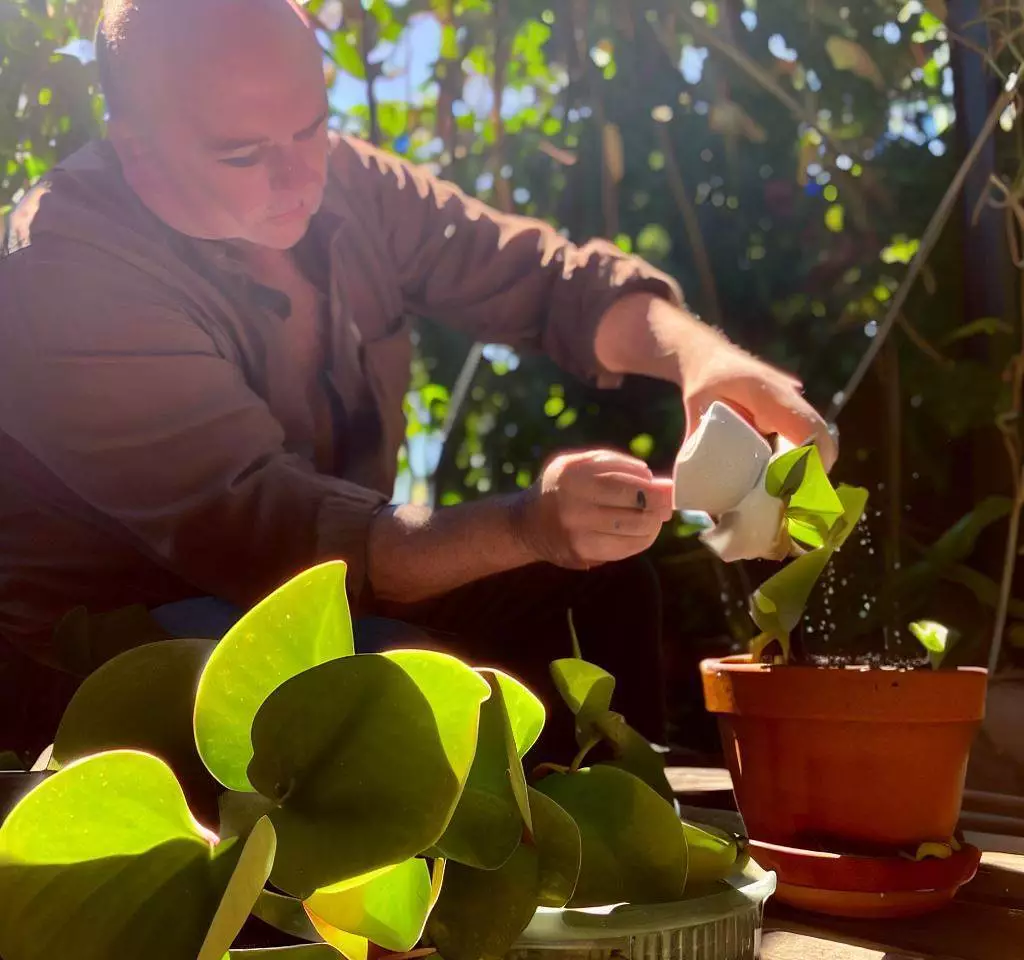
In its natural habitat, the plant is often exposed to high humidity levels, which can be easily replicated by misting the leaves or placing the plant in a humid environment, such as a bathroom or kitchen.
Hoya Burtoniae has become a popular houseplant due to its unique flowers and easy-to-care-for nature. As a result, the plant’s distribution in cultivation is likely due to its popularity and ease of propagation through cuttings.
Physical characteristics and features
This particular species of Hoya is a vining plant that can grow up to 10 feet (3m) long. Its leaves are thick, fleshy, and dark green with silver or white speckles. The plant’s stems are thick and hairy, and it can produce clusters of flowers throughout the year.
Growing and caring for Hoya Burtoniae
Hoya Burtoniae is a reasonably low-maintenance plant that is easy to care for. However, to ensure that it thrives, providing it with the right conditions is important. Let’s have a look at this type of plant’s ideal growing and caring conditions:
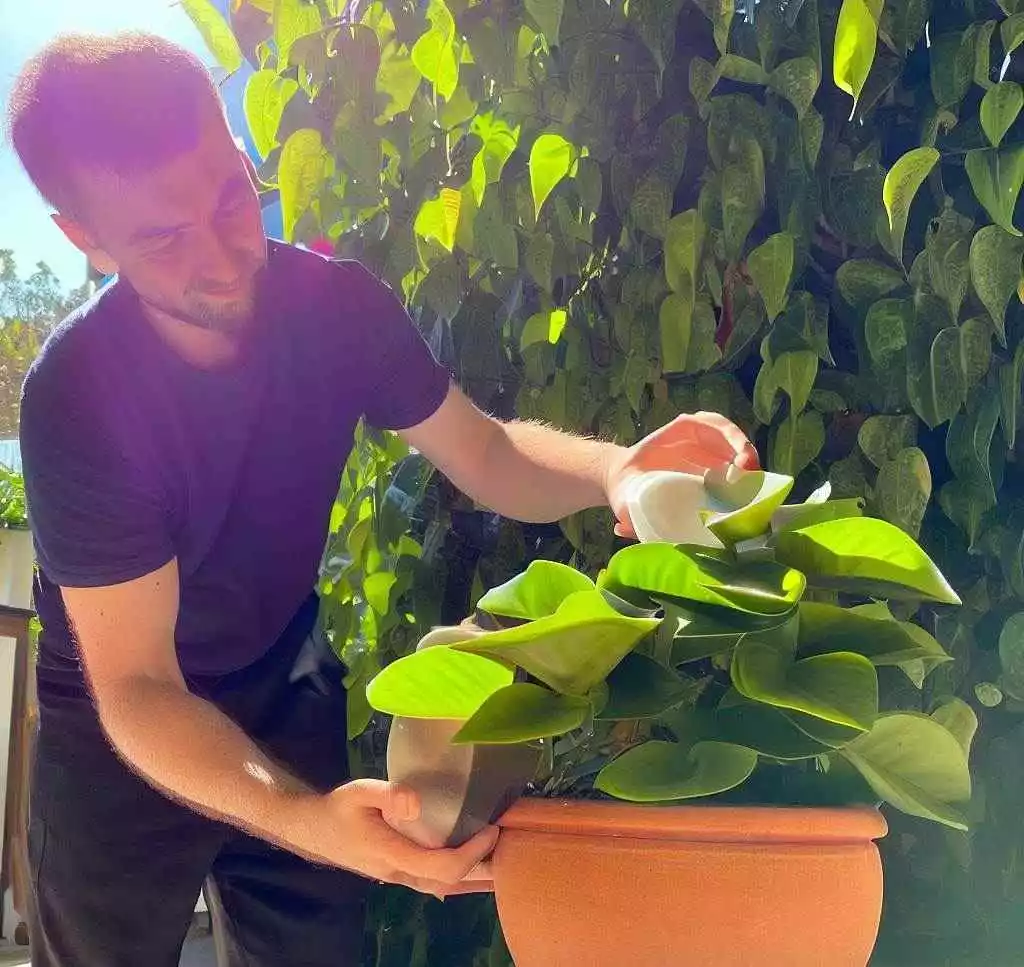
Light Requirements
Hoya Burtoniae thrives best when grown in around 4-6 hours of bright, indirect light daily. Exposing them to direct sunlight can burn the leaves, so placing the plant near a bright window is best, but not under direct sunlight. Having them stand in a north or east-facing window is ideal for this plant.
Temperature Preferences
The Hoya Burtoniae enjoys warmer temperatures, with their ideal range being between 60°F-80°F (15°C-27°C). This plant can tolerate cooler temperatures, but it should be protected from frost or extreme temperature changes.
Any lower than 60°F (15°C) may start to see them suffer from chill damage. They will be difficult to revive with temperatures below 50°F (10°C) for extended periods. Keeping the plant away from cold drafts and windows during the colder months is important.
Watering and Soil Needs
Hoya Burtoniae won’t tolerate an excessive amount of water. Therefore, allowing the soil to dry out between watering is important. Any stagnant water will form a bath for the roots. They will suffocate due to being surrounded by this moisture, leading to root rot.
Aim to water the plant only when the top layer of soil feels dry to the touch. When it comes to soil, these wonderful houseplants prefer well-draining soil rich in organic matter. Try to use compost or manure to help revitalize stale soil types.
However, if they become too compact, mix in some sand, gravel, or perlite to help with aeration. They also benefit from occasional fertilization during the growing season, using a balanced liquid fertilizer at half strength.
Humidity
Hoya Burtoniae is native to tropical regions. Therefore, it requires high humidity levels to grow well. They require humidity levels between 60% and 80%. If the humidity level is too low, the plant may suffer and be more prone to pests and diseases.
It is a good idea to mist the leaves regularly to increase humidity levels. Placing the plant on a tray of pebbles or using a humidifier can also help to maintain the ideal humidity level.
Pruning and Shaping
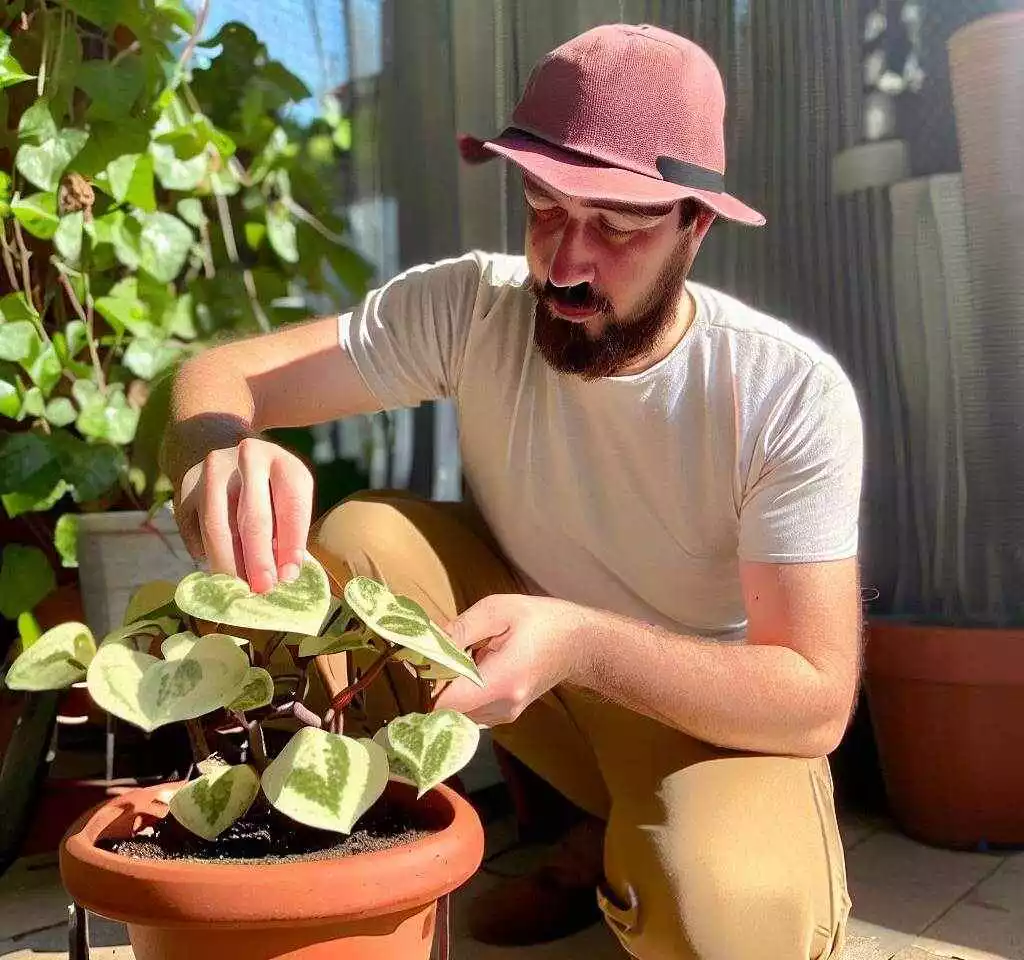
Hoya Burtoniae can be pruned to keep it in shape and promote new growth. Prune the plant in the spring after the flowering period is over. Use clean, sharp pruning shears to make clean cuts, and avoid cutting into the woody stems.
Propagation
These plants are easily propagated through stem cuttings. To propagate, cut from a healthy stem and plant it in well-draining soil. Keep the soil moist and warm until the cutting has rooted and grown.
Transfer when the roots have matured. It is also possible to propagate the plant by layering, which involves burying a stem partially in soil and allowing it to grow roots before cutting it from the parent plant.
Common problems and solutions
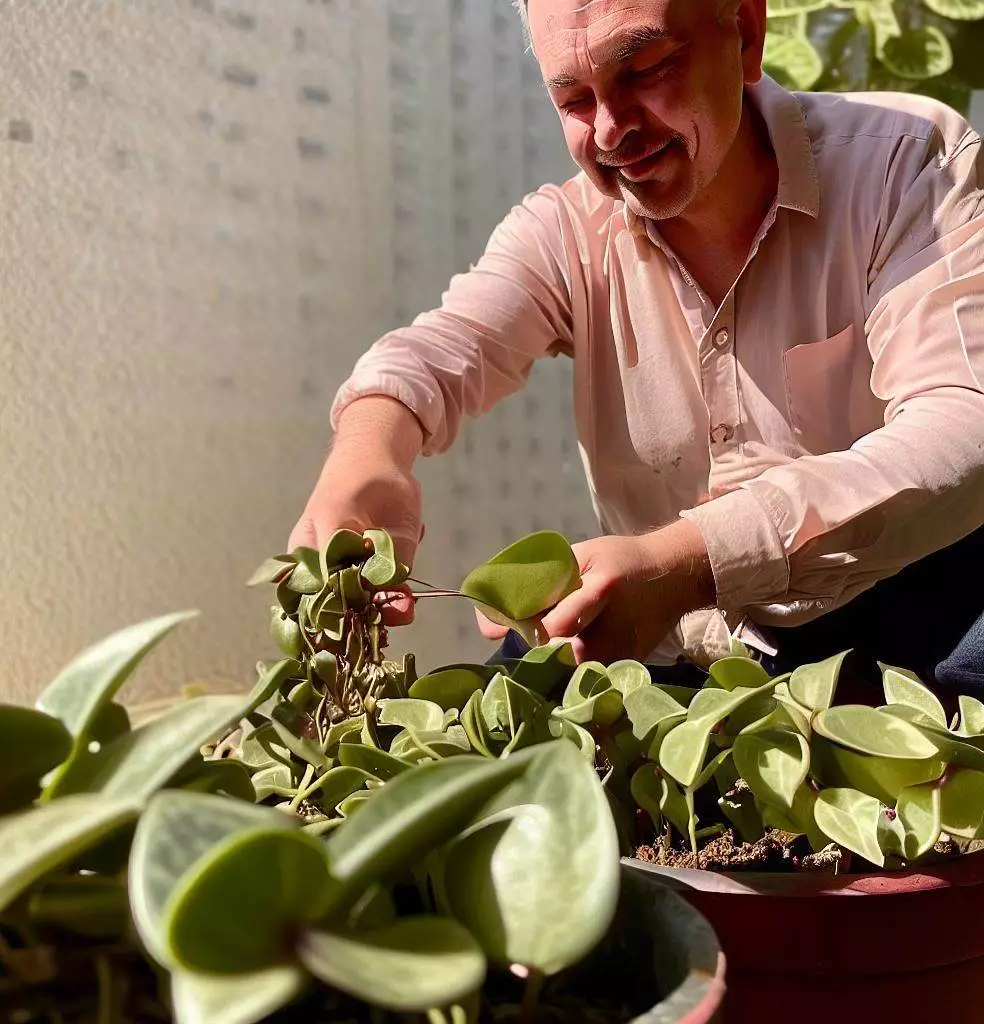
One of the most common issues with Hoya Burtoniae is overwatering, which can lead to root rot. To avoid this, ensure that the plant is not sitting in stagnant water, the soil is w ell-draining, and the container has adequate drainage holes.
Spider mites and mealybugs can also be problematic but can be easily treated with neem oil or insecticidal soap.
Hoya Bilobata: A Brief Overview
Description of Hoya Bilobata
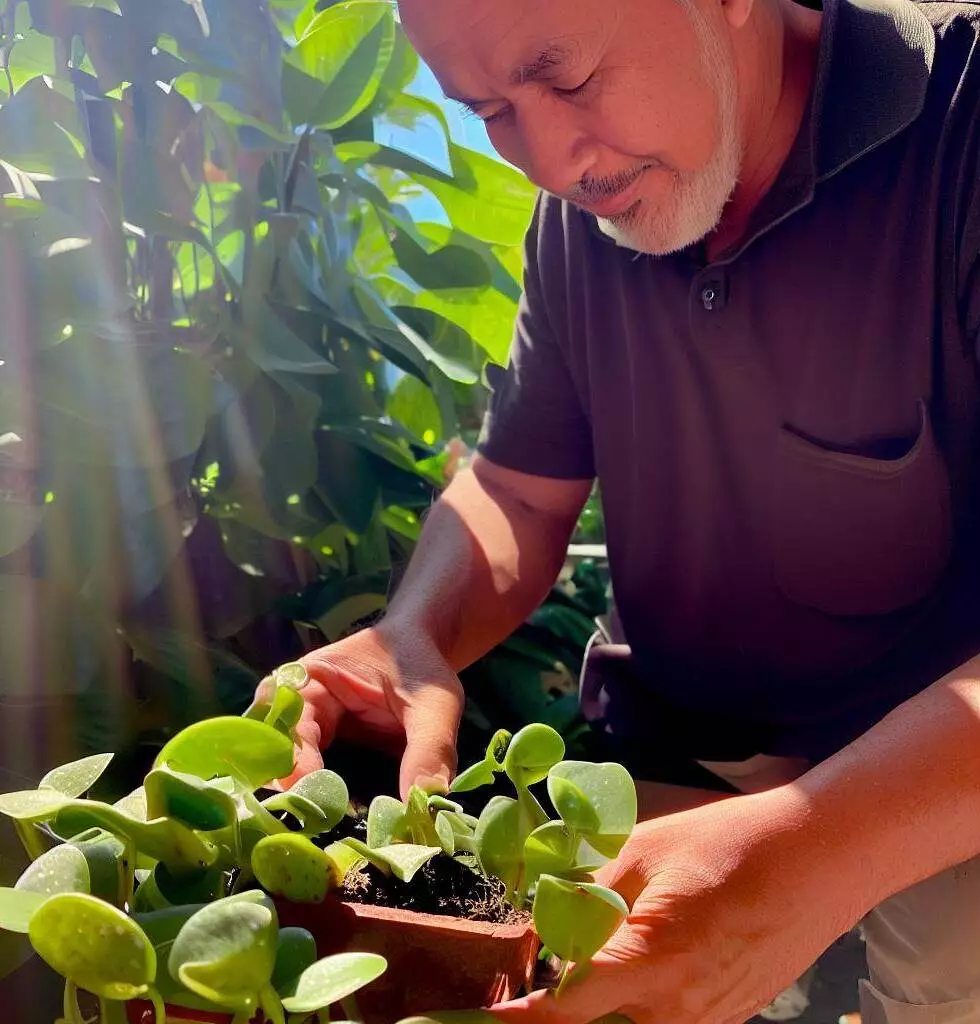
Hoya Bilobata, a.k.a. the Two-Lobed Hoya, is a unique and beautiful species of Hoya plant native to the Philippines. This plant produces clusters of small, star-shaped, white flowers with a sweet fragrance. The flowers have a unique feature of two small lobes on the tips of the petals, which give the plant its name.
Habitat and distribution
Hoya Bilobata has a similar habitat to its counterpart (Hoya Burtoniae). It’s also native to the tropical rainforests of the southern Philippines, primarily Luzon, Samar, and Mindanao. It also grows as an epiphyte on tall trees as it searches for light and rocks.
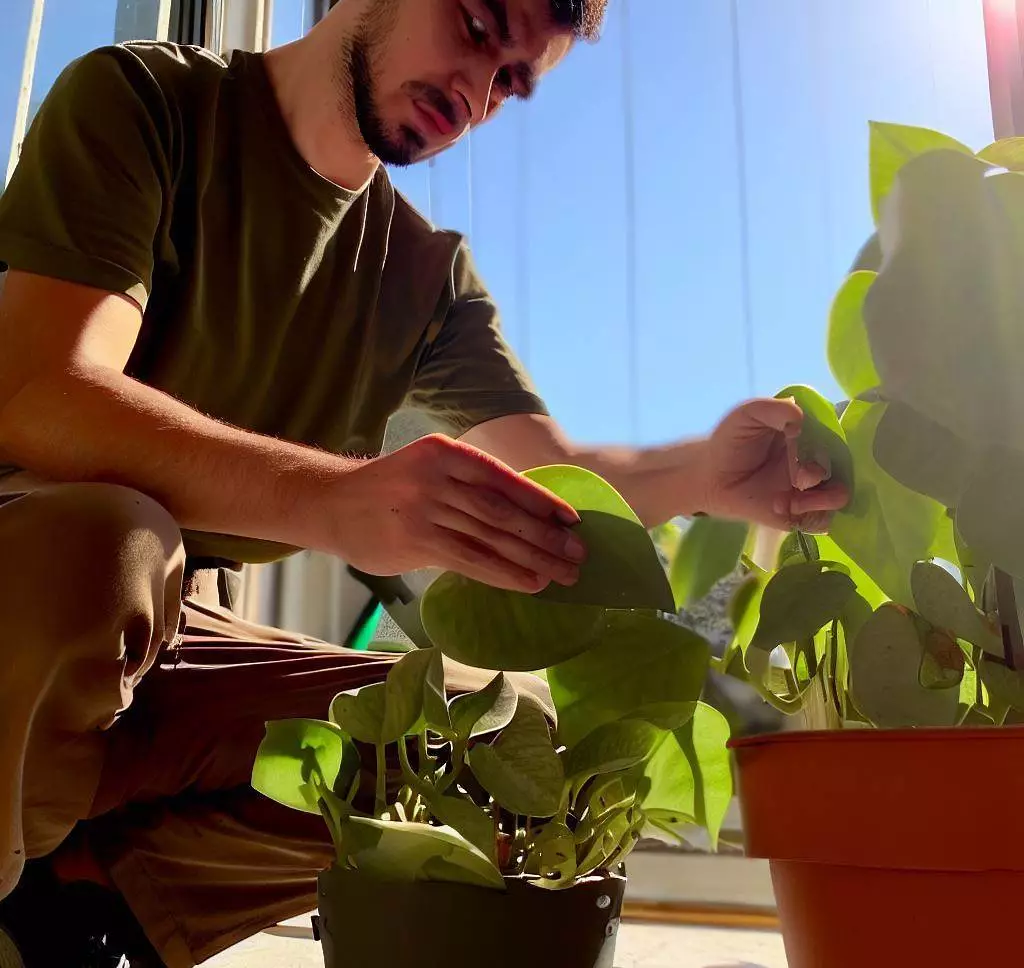
This plant’s leaves are thick and waxy, which helps it retain moisture and tolerate periods of drought. In its natural habitat, the plant is exposed to high humidity levels and filtered light, which can be replicated by misting the leaves or placing the plant in a humid environment, such as a bathroom or kitchen.
Hoya Bilobata is also cultivated in various parts of Southeast Asia and around the world. Like the Hoya Burtoniae, It has become a popular houseplant due to its unique flowers, easy-to-care-for nature, and ease of propagation through cuttings.
Physical characteristics and features
Hoya Bilobata is a slow-growing vining plant that can reach up to 10 feet (3m) in length. Its leaves are thick and waxy, with a deep green color and a glossy sheen. The leaves are also lanceolate in shape and grow up to around 3 inches in length. The plant’s flowers are small and star-shaped and come in clusters of up to 20 flowers.
Growing and caring for Hoya Bilobata
Hoya Bilobata is a relatively easy plant to grow and care for, making it an ideal plant for beginners. It is a tropical plant and prefers warm temperatures, high humidity, and bright but indirect light. Here are some tips for growing and caring for Hoya Bilobata:
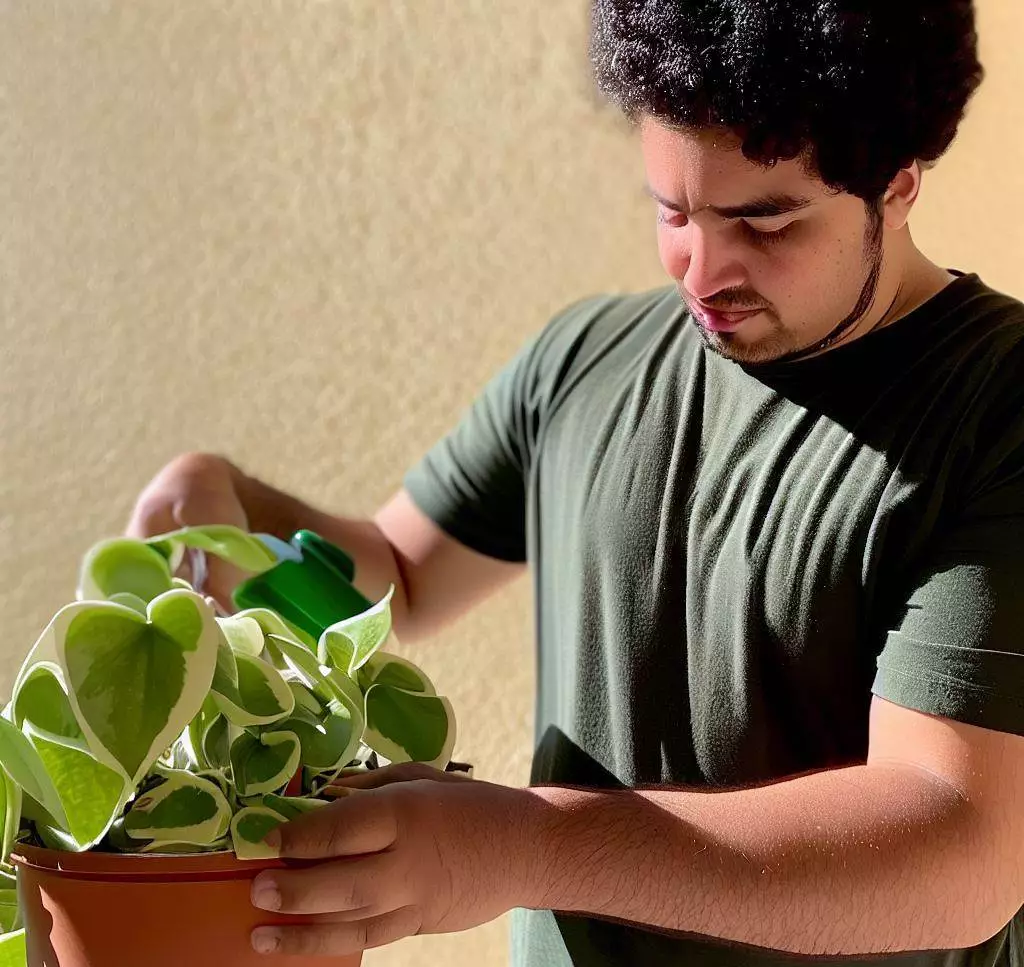
Light Requirements
Hoya Bilobata prefers at least 4-6 hours of bright but indirect light daily. When growing indoors, it’s best placed near a north or east-facing window, where it can receive filtered light. Exposing these plants to direct sunlight can scorch the leaves, so it is important to avoid placing them in these conditions at all costs.
Temperature Preferences
Much like its counterpart, Hoya Bilobata also prefers warm temperatures, with the ideal range being between 60°F- 80°F (15°C-27°C). It should be protected from frost and extreme temperature changes, as these can cause damage to the plant. When the mercury drops below 60°F (15°C), it will show signs of extreme stress.
This can be in the form of wilting, drooping, and mushy leaves. Any lower than (50°F (10°C) will freeze its moisture content which can cause the cell membrane to explode and be unrevivable.
Watering and Soil needs
Overwatering a Hoya Bilobata should be avoided. Instead, test the soil before each water session and ensure the top inch is bone dry before drip-feeding it. These types of plants are highly susceptible to root rot.
The Hoya Bilobata prefers adequately aerated, well-draining soil, and it should be planted in a pot with drainage holes. Clumpy, clay-like soils can be amended using something coarse like sand, gravel, or perlite.
Humidity
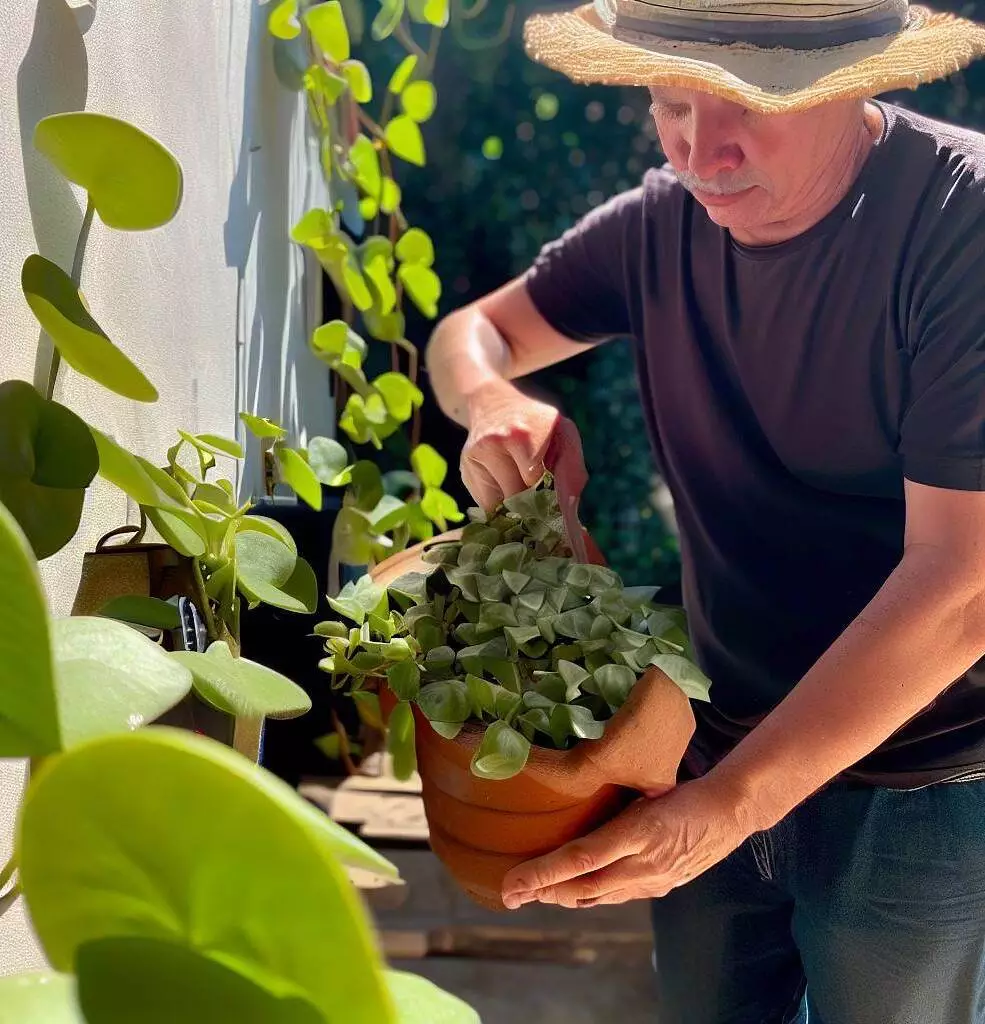
Hoya Bilobata is a tropical plant and requires high humidity levels to stay happy. The ideal humidity level for Hoya Bilobata is usually between 60%-80%. Humidity levels can be raised by misting the leaves regularly or placing the plant in a naturally humid environment, such as a bathroom or kitchen.
Pruning and Shaping
Pruning is quite simple when it comes to the Hoya Bilobata. It also helps to keep the plant in shape and promote new growth. The best time to prune Hoya Bilobata is during the spring, just before new growth emerges.
This will allow it to regenerate and produce fresh, new growth. Pruning can be done by cutting back the stems just above a leaf node.
Fertilizer
These plant species don’t require a lot in the way of fertilization. However, it can benefit from a balanced, water-soluble fertilizer during its prime growing season (spring and summer). Remember to always follow the manufacturer’s instructions for usage dilution and frequency of application.
Common problems and solutions
As with Hoya Burtoniae, the most common issue with Hoya Bilobata is overwatering. This problem can be amplified when its growing medium is prepared poorly, and drainage holes are inadequate.
As a result, the excess water stagnates in the base of the growing container, creating a bath for the roots to rot away in, hence the name ‘root rot.’
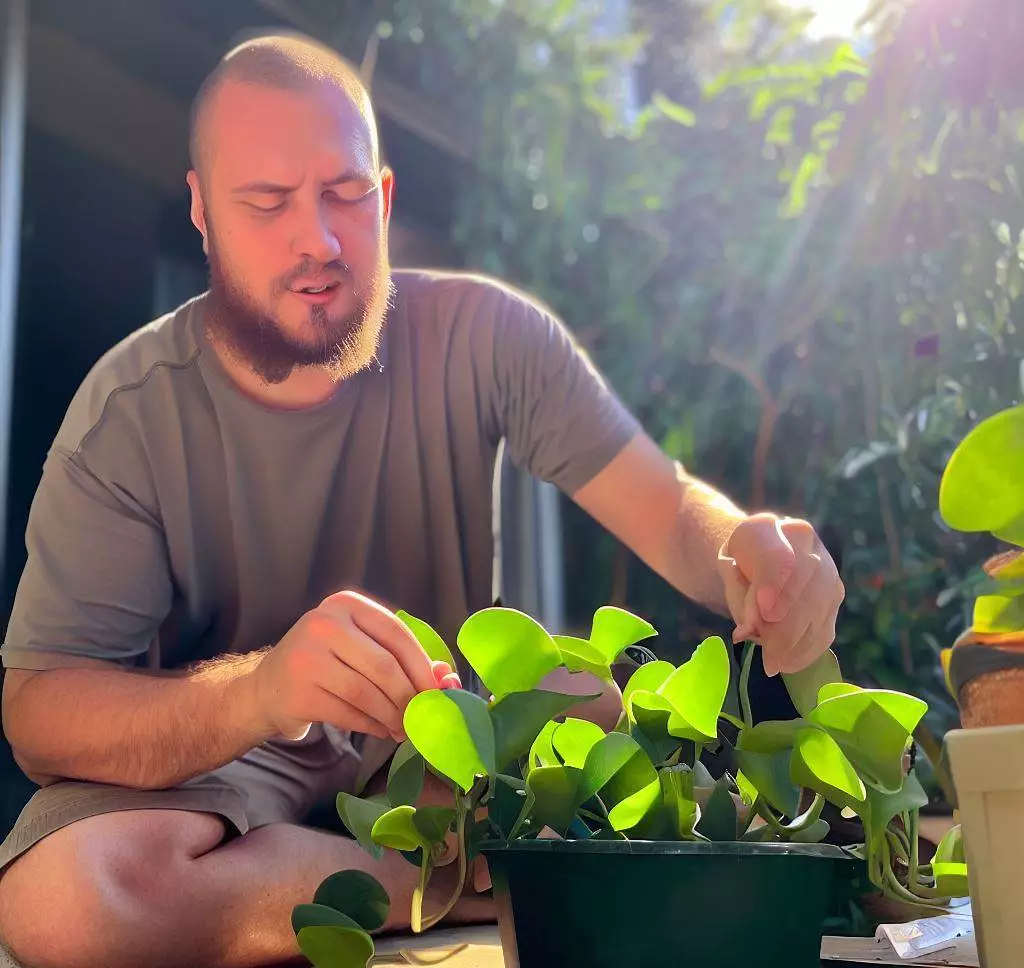
Another issue that can cause unwanted headaches is the possible infestations of Spider mites and mealybugs. However, they can be treated with neem oil or insecticidal soap if spotted early.
Lastly, the plant may require some support as it grows. The leaves can generally become a bit top-heavy and may need the aid of a stake or trellis to help them climb.
Once they establish themselves on the climber, they can usually propel themselves upwards easily.
Hoya Burtoniae vs Bilobata: All Key Differences
Hoya Burtoniae and Hoya Bilobata are both members of the Hoya family and share many similarities in terms of their care requirements and propagation techniques.
However, some key differences between the two plants make them distinct from each other.
Leaves
One of the most noticeable differences between Hoya Burtoniae and Bilobata is their leaves. Hoya Burtoniae has beautiful large, fleshy leaves that are glossy and oval-shaped, with a pointed tip. The leaves are deep green and can grow up to 10 cm long.
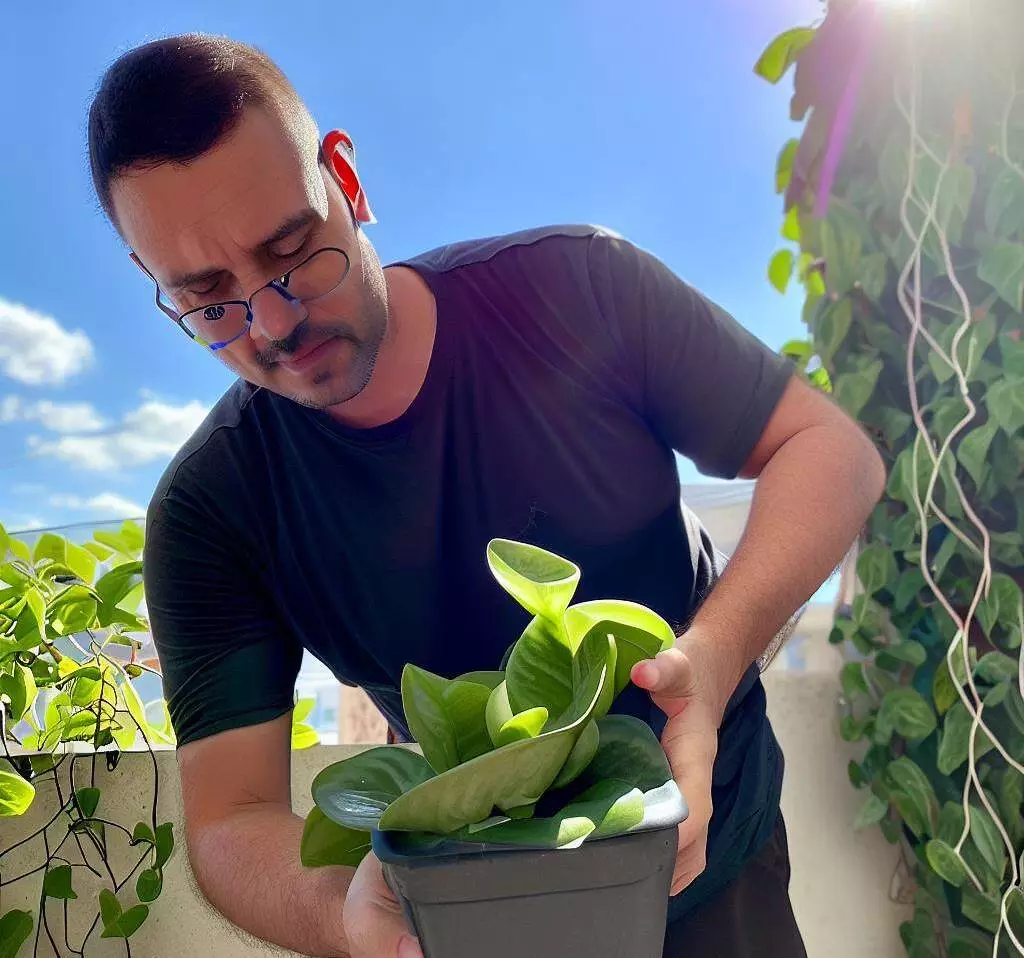
On the other hand, Hoya Bilobata has smaller, thicker leaves that are darker green and shaped like a sharp lance. The leaves of Hoya Bilobata are shorter at around 5 cm long, and have a slightly waxy texture.
Flowers
Another key difference between Hoya Burtoniae and Bilobata is their flowers. Hoya Burtoniae produces clusters of small, star-shaped flowers that are pink in color with a reddish-pink center. The flowers have a sweet, fruity fragrance and can bloom at any time of year.
Hoya Bilobata, on the other hand, produces flowers that are more striking in appearance. They have a star shape and a deep maroon center surrounded by pale pink or white petals. The flowers are also fragrant, with a sweet scent similar to Hoya Burtoniae.
Growth habit
Hoya Burtoniae and Hoya Bilobata have different growth habits. Hoya Burtoniae is a trailing plant that can grow up to 1 meter in length, with long, slender stems that can climb or cascade.
Hoya Bilobata, on the other hand, is a more compact type of plant that grows upright. It has thick, woody stems and a bushy appearance.
Light Requirements
Hoya Burtoniae and Bilobata prefer bright but indirect light and can be damaged by too much direct sunlight. The leaves become scorched when exposed for too long.
However, Hoya Burtoniae is more tolerant of lower light conditions and can be grown in lower light areas of the home.
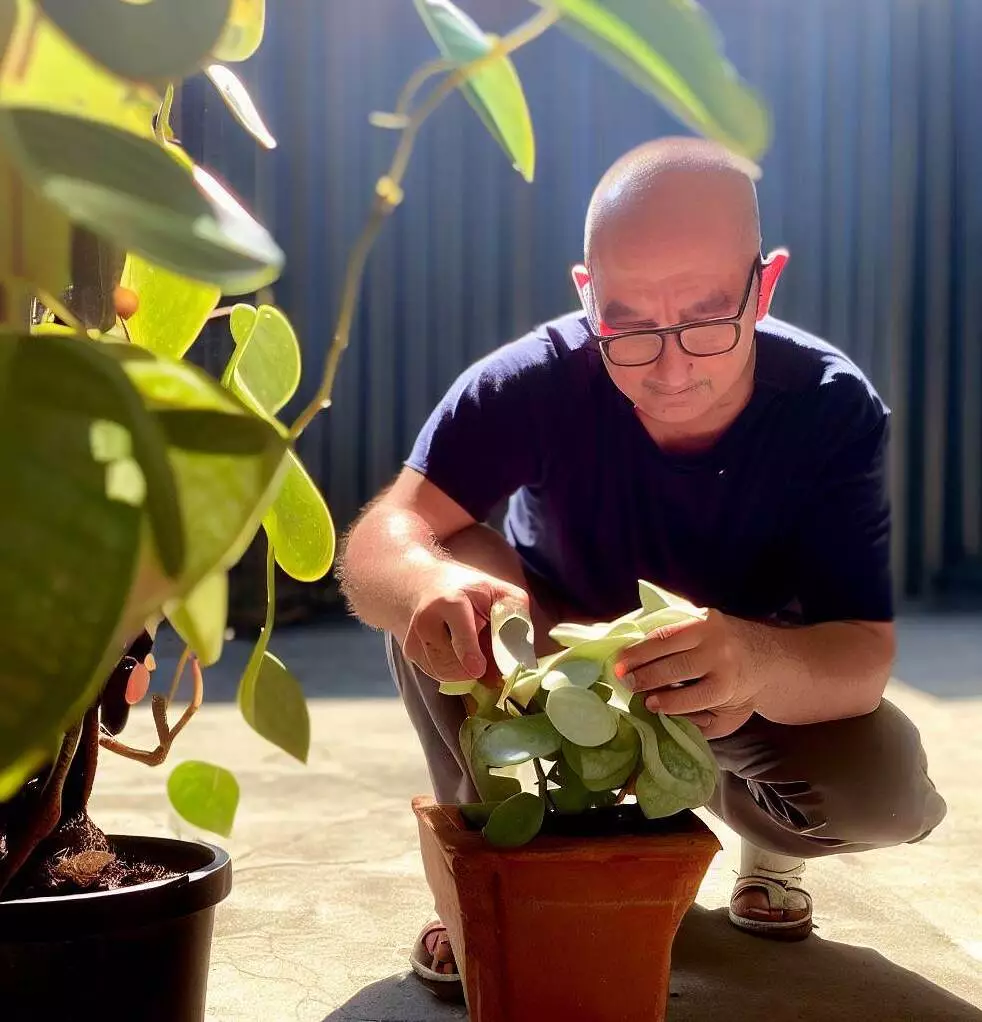
Hoya Bilobata, on the other hand, requires brighter light to produce the most vibrant blooms. Light for both of these plants can be mimicked by using artificial lights.
It’s worth noting that you will need to find a type of light that doesn’t produce strong, direct light. Instead, it should be much softer and less harsh.
Temperature Preferences
Hoya Burtoniae and Bilobata both prefer warm temperatures and are sensitive to cold temperatures. However, Hoya Burtoniae is more cold-tolerant and can withstand temperatures as low as 50°F (10°C).
Hoya Bilobata, on the other hand, is more sensitive to cold and should be kept in temperatures above 60°F (15°C).
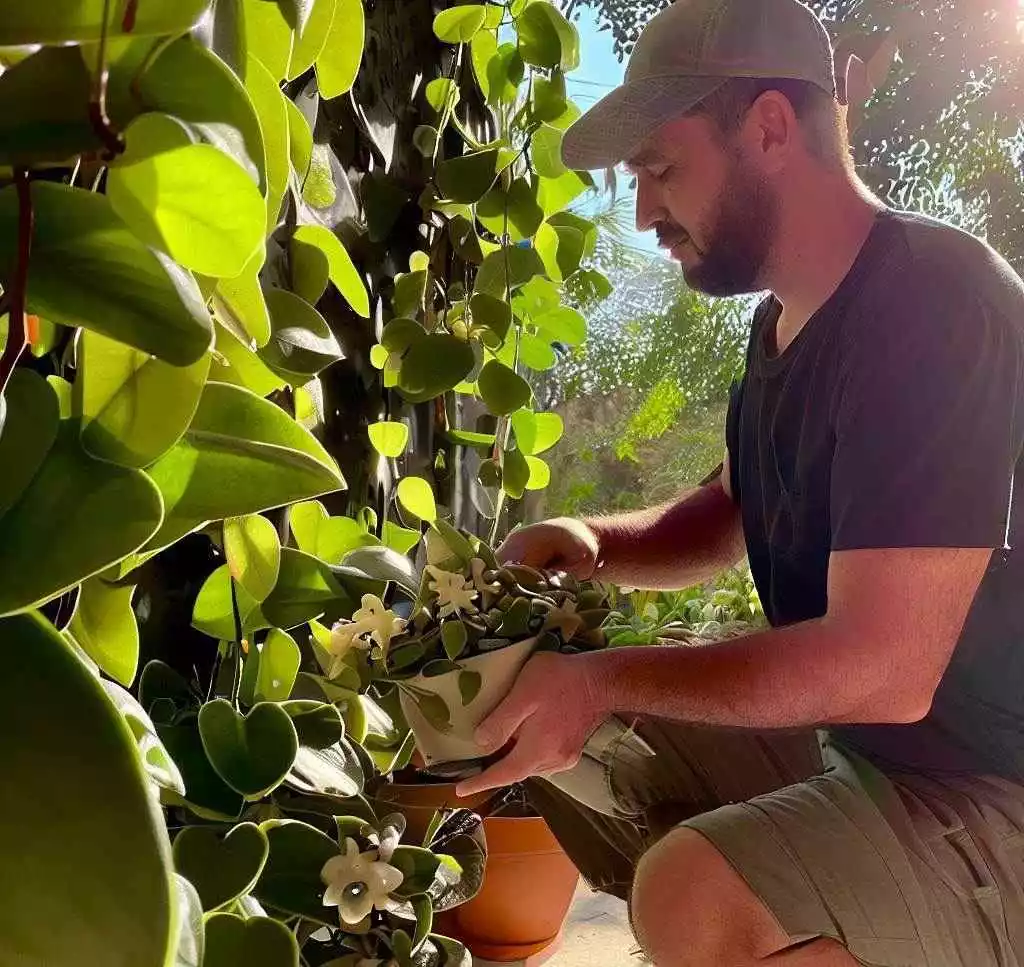
Either way, exposing them to any chill level can do permanent damage. Always place them somewhere where they have a windbreak or cover overhead. When the mercury drops too low, it’s much easier to bring them inside, where the temperature can be controlled.
Watering and Soil Needs
The main thing to remember with both of these plants is to prepare their growing medium with well-draining soil. This can be amended with coarse materials such as sand, gravel, and/or perlite.
Additionally, try to plant them in a container that has adequate drainage. We cannot stress this enough. Any excess water should be drained away quickly to prevent root rot issues via overwatering.
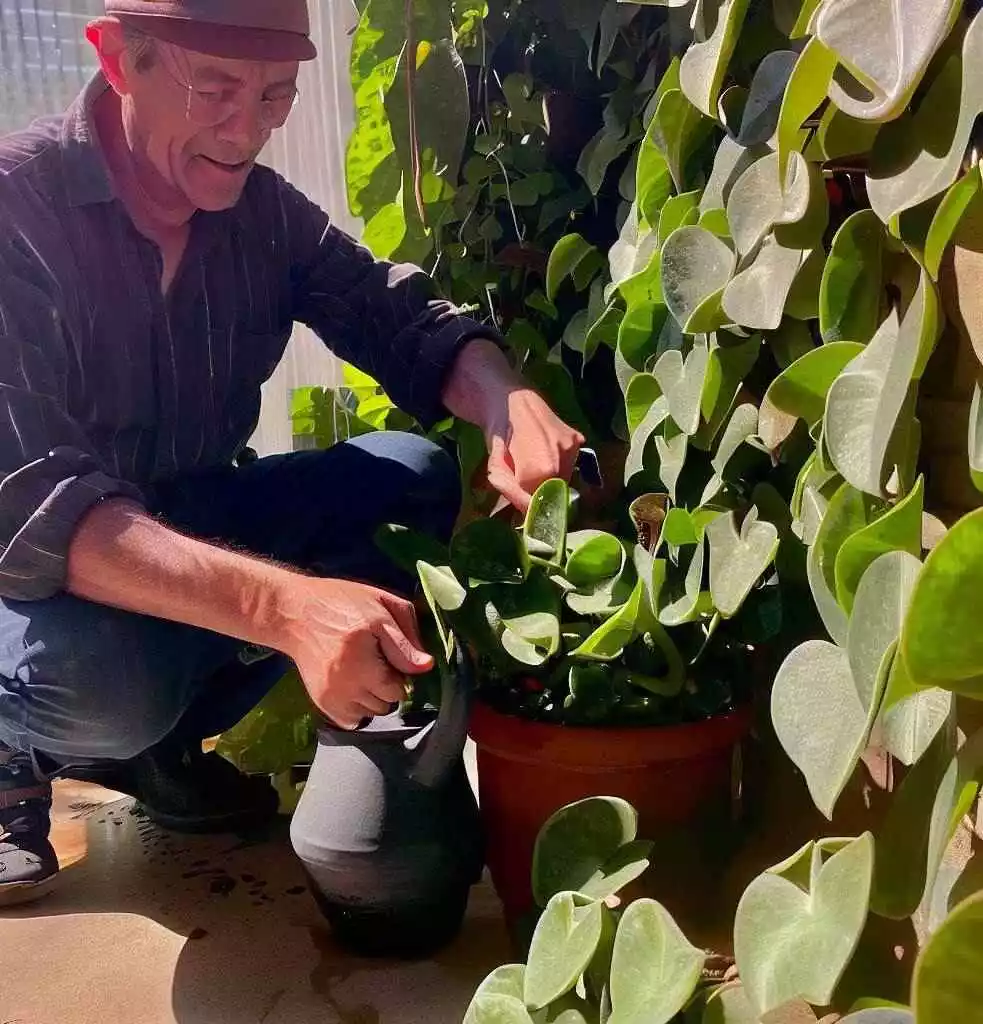
Hoya Burtoniae and Bilobata should be watered only when the top layer of soil is dry to the touch. Hoya Bilobata is more susceptible than its counterpart to root rot and should be watered slightly less frequently than Hoya Burtoniae.
Lastly, Hoya Bilobata prefers more acidic soil than Hoya Burtoniae so keep that in mind when preparing. If unsure, take a simple soil sample test and amend accordingly.
Humidity
Hoya Burtoniae and Bilobata prefer high humidity levels, but Hoya Bilobata is more sensitive to swinging changes in humidity levels. Hoya Bilobata should be placed in a consistently humid environment, such as a bathroom or kitchen, to maintain optimal growth and prevent damage to the leaves and blooms.
Both of these plants like being exposed to humidity levels ranging between 60-80%, slightly above that of the common home. Levels can be raised by misting, adding humidifiers, and even leaving a shallow tray of water near your plants.
Pests and Diseases
Hoya Burtoniae and Bilobata are generally hardy and relatively pest and disease-resistant. However, like all plants, they can be susceptible to certain pests and diseases.
Here are some common issues to be aware of when caring for your Hoya plants:
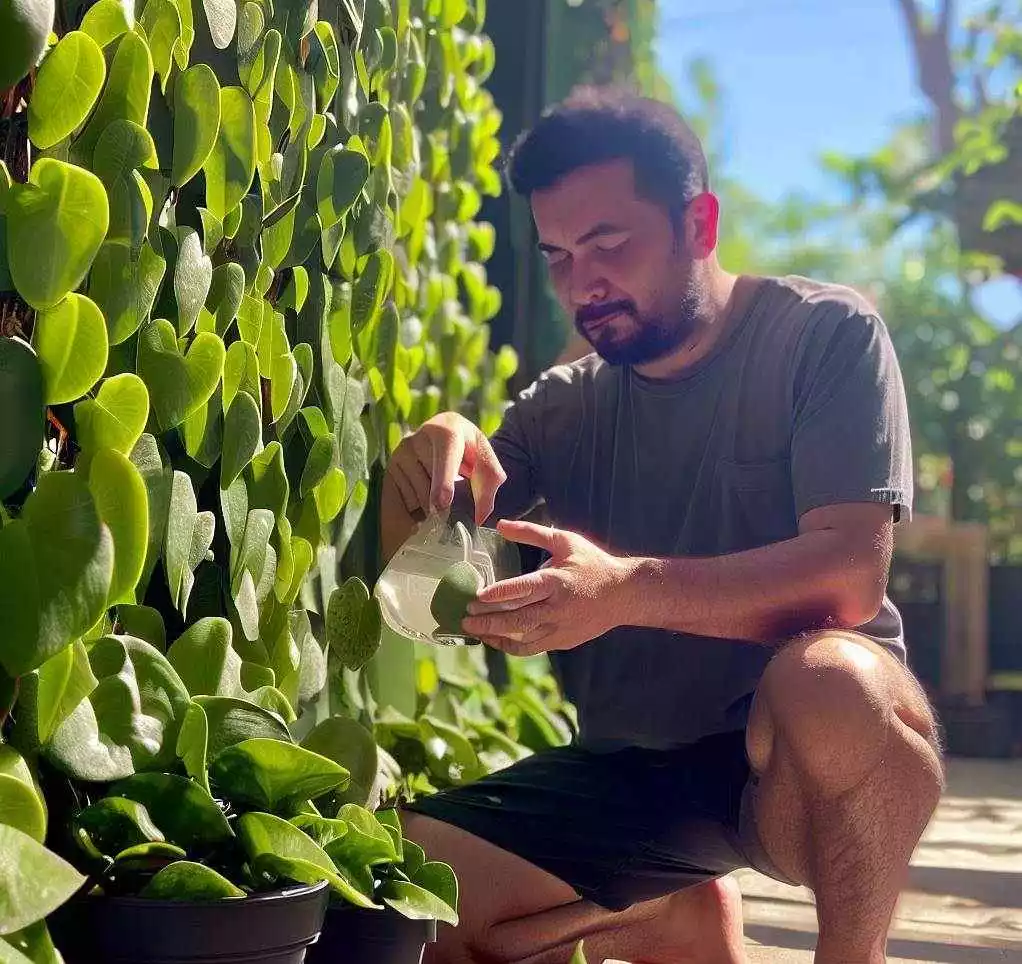
Pests
Mealybugs
Mealybugs are small, white, cottony insects that can infest the leaves, stems, and blooms of Hoya plants. They can cause damage to the plant by sucking out the sap, which results in stunted growth, leaf drop, and wilting. If left untreated, a severe infestation can cause the plant to die.
Symptoms: Signs of a mealybug infestation include white cottony masses on the leaves, stems, blooms, and sticky honeydew residue.
Spider Mites
Spider mites are tiny, sap-sucking insects that can cause severe damage to Hoya plants. They are typically found on the undersides of the leaves and can cause the leaves to turn yellow and dry out. If these little buggers aren’t wiped out early, they will take over and kill the plant.
Symptoms: Signs of a spider mite infestation include tiny webs on the leaves and stems and speckled, yellowing leaves.
Diseases
Root Rot
Root rot is a fungal disease that can affect Hoya plants if they are overwatered or planted in soil that does not drain well. The fungus can cause the roots to rot, which leads to wilting, yellowing leaves, and stem collapse.
If the plant is left to rot, it will slowly spread up through it and won’t be revived.
Symptoms: Signs of root rot include a foul odor, blackened or mushy roots, and yellowing or wilting leaves.
Leaf Spot
Leaf spot is a fungal disease that can affect Hoya plants when exposed to high humidity or crowded growing conditions. The fungus can cause circular, brown spots on the leaves, leading to leaf drop and stunted growth. Untreated leaf spots can lead to the death of these plants.
Symptoms: Signs of leaf spots include brown spots on the leaves and yellowing or dropping leaves.
Regular monitoring of your Hoya plants can help you catch any pest or disease issues early on, allowing you to treat them before they become severe.
Other distinguishing features
Aside from the growth habits, light requirements, temperature preferences, watering and soil needs, humidity, pests, and diseases, there are some other distinguishing features between Hoya Burtoniae and Bilobata to take note of:
- Vine Texture: The vine texture of the two plants is slightly different. Hoya Burtoniae has a thin, flexible vine that can be trained to grow in a certain direction, while Hoya Bilobata has a more rigid vine that tends to grow upright.
- Leaf Arrangement: The arrangement of the leaves is also slightly different. Hoya Burtoniae has a more clustered leaf arrangement, with the leaves growing closer along the vine. Hoya Bilobata, on the other hand, has a more spaced-out leaf arrangement, with the leaves growing farther apart along the vine.
- Foliage Color: The foliage on the two plants is also slightly different. Hoya Burtoniae has dark green leaves that sometimes have a reddish tint, while Hoya Bilobata has lighter green leaves with more pronounced veining.
- Bloom Frequency: While both Hoya Burtoniae and Bilobata are known for their beautiful blooms, the frequency of blooming can differ. Hoya Burtoniae tends to bloom more frequently than Hoya Bilobata, with blooms appearing throughout the year under the right conditions.
By paying attention to these distinguishing features, you can more easily differentiate between Hoya Burtoniae and Bilobata and give them the specific care they need to thrive.
Similarities between Hoya Burtoniae and Bilobata
While there are some key differences between Hoya Burtoniae and Bilobata, there are also many similarities between the two plants. Here are some commonalities to be aware of:
General care requirements
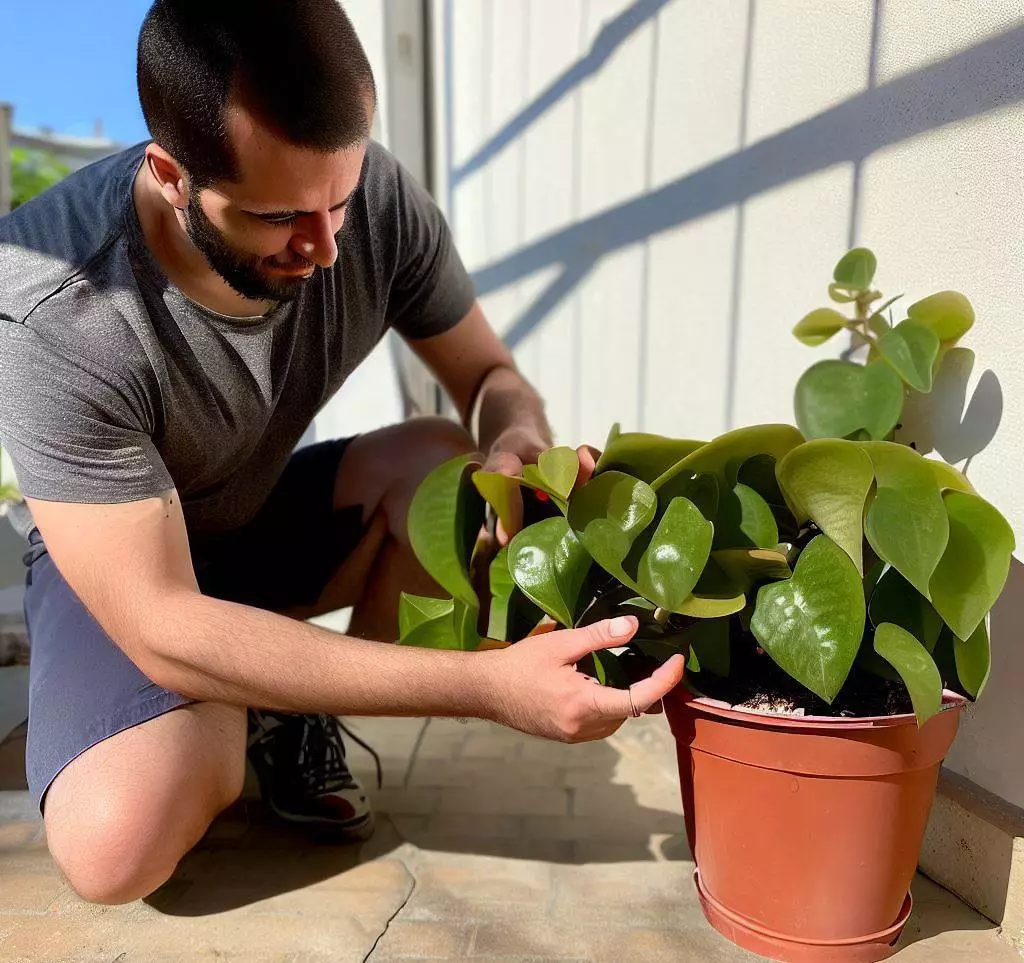
Both Hoya Burtoniae and Bilobata have similar care requirements. They prefer bright but indirect light, high humidity, and well-draining soil.
They can both be sensitive to overwatering, so it’s important to let the soil dry out between waterings. On the upside, they grow quite well together due to similar growing needs.
Propagation techniques
Hoya Burtoniae and Bilobata can be propagated through stem cuttings or layering. Stem cuttings are the most common method and involve cutting from the parent plant and rooting it in either soil or water.
Layering involves rooting a stem while it’s still attached to the parent plant, then separating it and potting it once its roots have been established.
How to propagate Hoya Burtoniae and Bilobata?
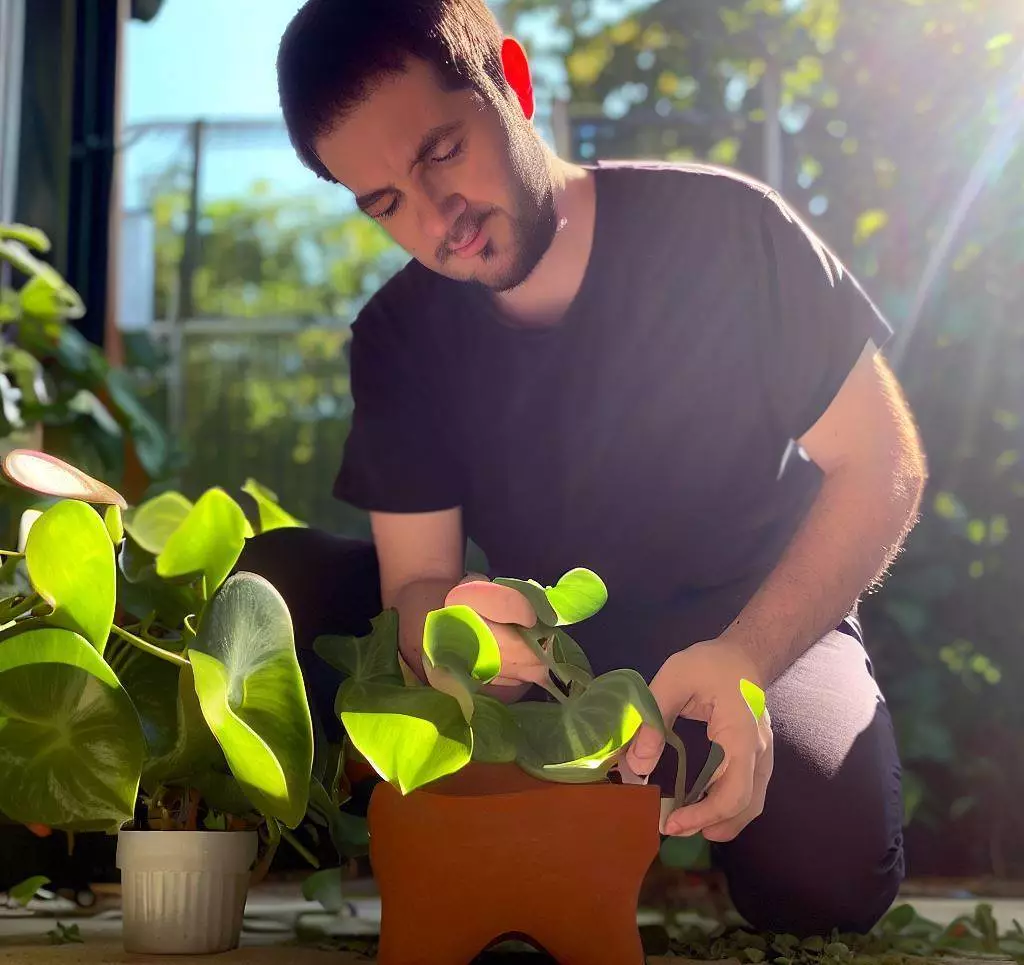
To propagate Hoya Burtoniae or Bilobata through stem cuttings, follow these steps:
- Take a cutting from the parent plant. Make sure that it’s at least 4-6 inches long and has several sets of leaves.
- Remove the leaves from the bottom 2-3 inches of the stem.
- Add some rooting hormone (or even honey) to the cut end of the stem.
- Plant the stem in well-draining soil or water. Keep it in a warm, bright spot with high humidity.
- Once the stem has rooted, move it to a well-draining mix and care for it like a mature plant.
Which propagation method works best for each species?
Both Hoya Burtoniae and Bilobata can be propagated using either method, but stem cuttings are the most common and reliable way to propagate these plants.
Ideal growing conditions
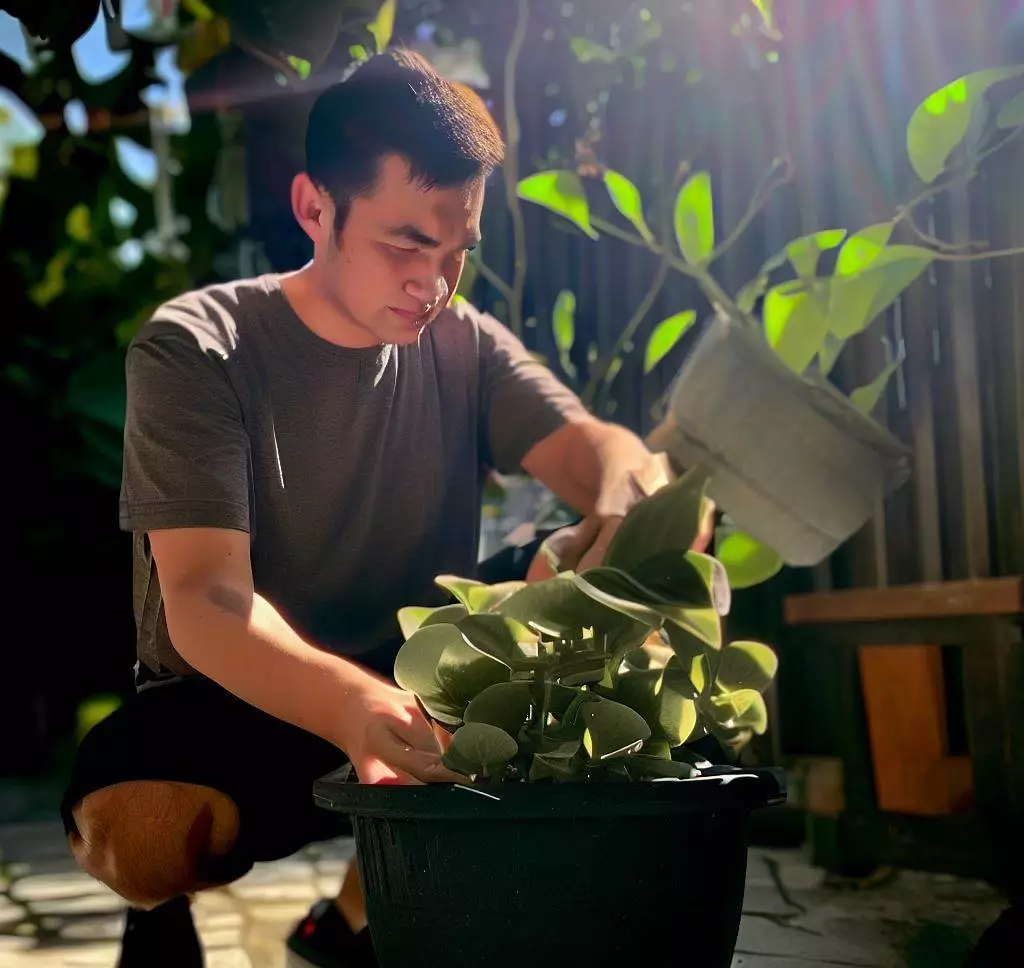
Hoya Burtoniae and Bilobata thrive in warm, humid environments with bright, indirect light. They can be grown in pots or hanging baskets, and both benefit from regular pruning and shaping to promote healthy growth.
Additionally, they prefer well-draining soil that allows excess moisture to drain away quickly, and they can be fertilized with a balanced fertilizer every few months to promote healthy growth.
Additional Care and Maintenance Tips
While Hoya Burtoniae and Bilobata are generally easy to care for, they still require regular maintenance to keep them healthy and happy. Here are some additional care and maintenance tips to keep in mind:
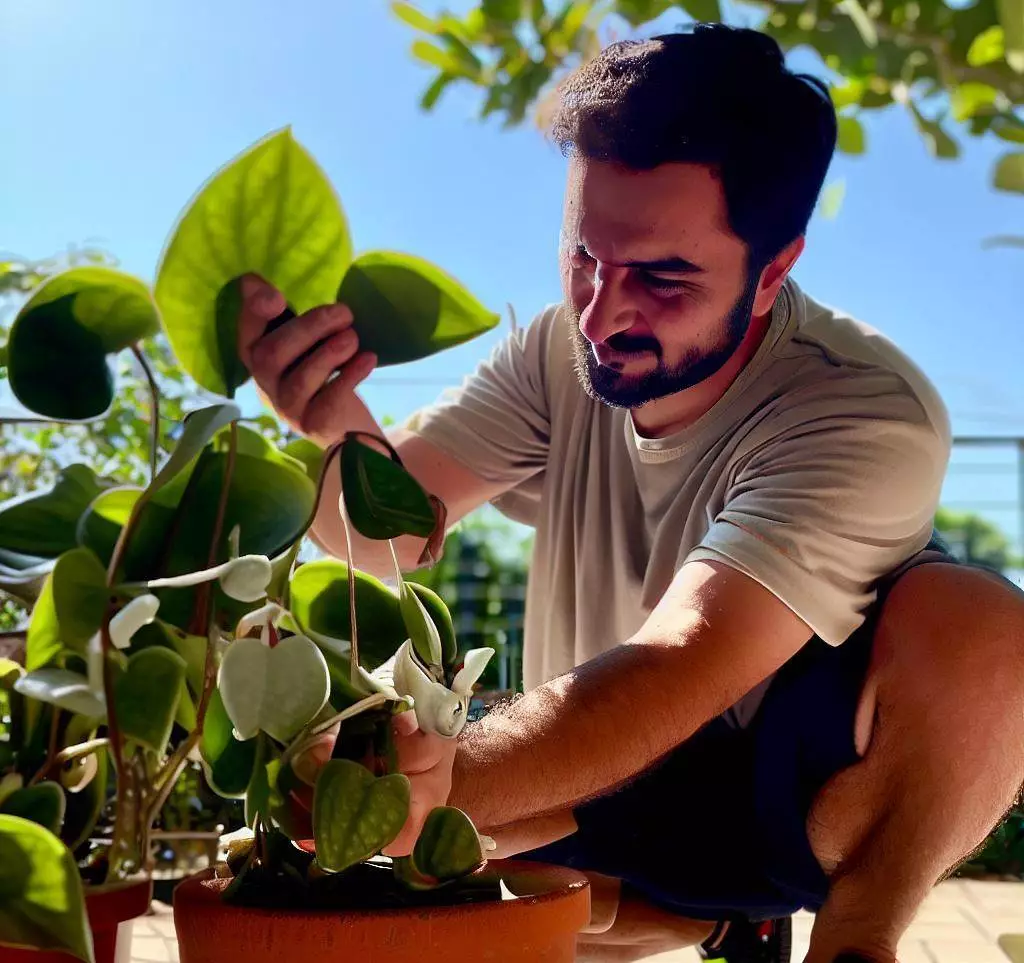
Pruning and shaping techniques
To keep your Hoya plants looking their best, it’s important to give them some regular pruning to help remove dead or decaying limbs and shape them. This can help promote healthy growth, prevent legginess, and encourage blooming.
Pruning is quite a simple task and can be done by taking a clean, sharp pair of scissors or pruning shears and snipping off any dead or damaged foliage. You can also pinch back the stems to promote branching and fuller growth.
Fertilizing requirements
Fertilization is not essential for these types of plants. However, Hoya Burtoniae and Bilobata can gain major benefits from regular fertilizing, promoting healthy growth and blooming.
Use a balanced fertilizer every few months during the growing season, and dilute it to half-strength to avoid over fertilizing.
Avoid feeding them during the colder months as their dormant state will suffer from the excess nutrients.
Repotting guidelines
Hoya plants don’t need to be repotted very often. However, it’s still an important part of their maintenance to repot them occasionally to refresh the soil and give them room to grow.
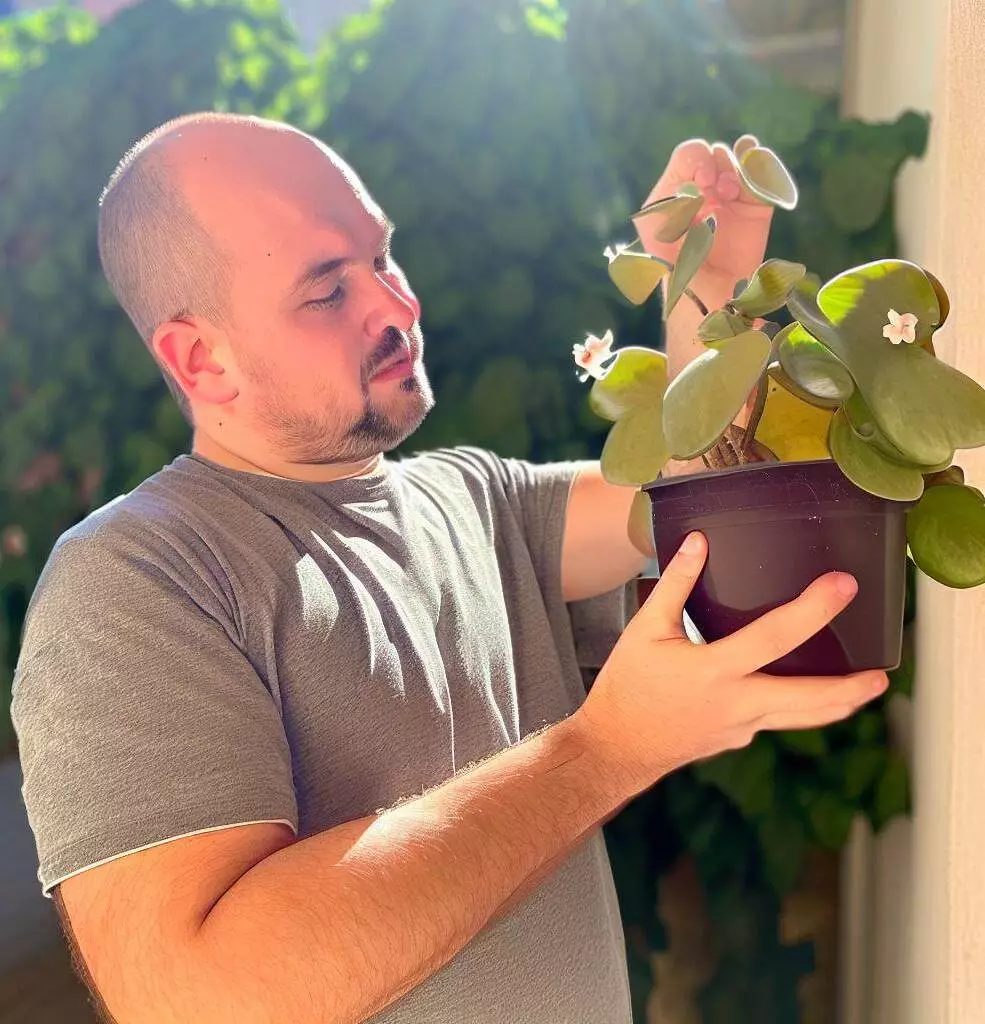
Repot your Hoya plants when you notice that their roots are starting to fill the pot and emerge from the drainage holes. Use a well-draining potting mix, and don’t bury the stem too deeply. Avoid overwatering at all costs.
Common issues and how to resolve them
Hoya plants can be prone to a few common issues, including root rot, pests, and leaf drop. To prevent root rot, use well-draining soil and let the soil dry out between waterings.
To prevent pests like mealybugs or spider mites, inspect your plants regularly and treat them with insecticidal soap or neem oil if you notice any infestations.
If your Hoya plants drop leaves, it may be a sign of stress due to overwatering, too much or too little light, or other environmental factors.
Following these additional care and maintenance tips, you can keep your Hoya Burtoniae and Bilobata plants looking their best and enjoying a long, healthy life in your home or garden.
Displaying Ideas for Hoya Burtoniae and Bilobata
When displaying Hoya Burtoniae and Bilobata plants, there are countless creative options to explore. From traditional pots and hanging baskets to mounted displays and terrariums, these plants can add a unique touch of natural beauty to any home or garden.
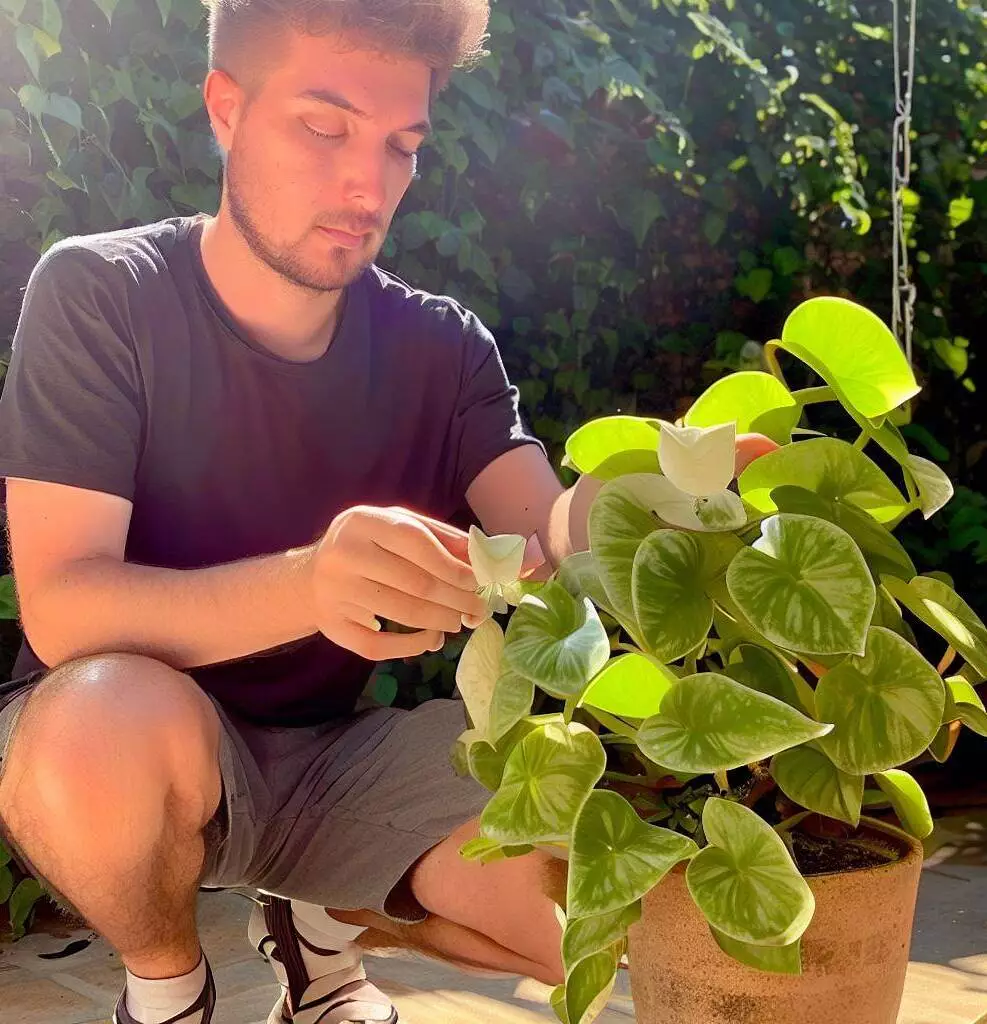
Creative ideas on how to display Hoya Burtoniae and Bilobata
Hoya Burtoniae and Bilobata are beautiful and unique plants that can be displayed in various ways to showcase their natural beauty. Here are some creative ideas on how to display your Hoya plants:
Potting options
Hoya plants can be grown in various containers, from traditional pots to hanging baskets, and even mounted on walls or trellises. They also look great in decorative planters or terrariums. These types will help highlight their delicate foliage and unique blooms.
Ways to showcase their unique beauty
Hoya plants are known for their stunning foliage and beautiful, fragrant flowers. One way to showcase their unique beauty is to display them in a brightly lit area where their leaves can catch the light and create a beautiful, natural display.
You can arrange them with other plants or use them to create a striking focal point in your home or garden.
Another great way to display your Hoya plants is to let them climb or trail, allowing their long stems to drape down over the sides of a pot or trellis. This can create a beautiful, organic look highlighting their unique growth habits and delicate blooms.
By experimenting with different potting options and display ideas, you can find the perfect way to showcase your Hoya Burtoniae and Bilobata plants and enjoy their natural beauty in your home or garden.
Frequently Asked Questions (FAQs)
Can Hoya Burtoniae and Bilobata be grown together?
Yes, they can be grown together as they have similar care requirements.
How often should I water my Hoya Burtoniae and Bilobata?
Water your Hoya plants only when the top layer of soil is dry. Overwatering is a no-no and should be avoided as it leads to root rot. Especially if the growing medium is prepared with soil that doesn’t offer adequate drainage or the container has no drainage holes.
Do Hoya Burtoniae and Bilobata require a lot of sunlight?
No, Hoya Burtoniae and Bilobata don’t require a lot of direct sunlight but need bright, indirect light for at least 4-6 hours each day. This could be somewhere like near a south-facing window. Too much direct sunlight can scorch their leaves.
What is the best soil mix for Hoya plants?
A well-draining potting mix with perlite or sand added for extra drainage is best for Hoya plants.
Conclusion:
In conclusion, Hoya Burtoniae and Bilobata are two unique and fascinating plant species with distinct characteristics and care requirements.
By understanding their differences and similarities, you can provide them with the best possible care and watch them thrive in your home or garden.
Remember to provide them with bright, indirect light, well-draining soil, and proper humidity levels, and be sure to prune and fertilize them regularly.
We hope that this guide has been helpful. You can read about similar topics here on our website. Check back again soon for more.


